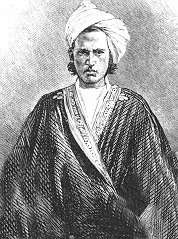Abadir Umar ar-Rida
Sheikh Abaadir Umar Al-rida (Harari: ኣው ኣባዲር, Somali: , Arabic: الفقيه عمر الرضا أبادر البكري الصديقي التيمي), also known as Fiqi Umar[1] was Emir of Harar and patron saint in modern-day eastern Ethiopia. He is regarded as the immediate common patriarch of the Arsi Oromo,[2] Hadiya-Halaba, Harla-Harari and the Somali sheekhaal clan. he is a well documented saint of Islam , he spread Islam throughout Ethiopia and Somalia after his migration from southern Arabian Hijaz Province.
Umar Al-Rida
الفقيه عمر الرضا أبادر التيمي | |
|---|---|
 | |
| Born | |
| Died | |
| Occupation | Cleric |
| Title | Sheikh |
| Children | 13 |
History
Ar-Rida is the main figure in the Fath Madinat Harar, an unpublished history of Harar in the 13th century. According to the account, he along with several other religious leaders traveled from the Hijaz region of present-day Saudi Arabia to Harar in 612H (1216 AD).[3] Other sources however claim he arrived in 999 AD and became Emir of Harar.[4][5] Ar-Rida subsequently married a Harari woman, and constructed the city's Jamia mosque.[1]
Descendants
The Somali sheekhaal clan trace descent to Sheikh Abadir ar-Rida, also known as Fiqi Umar.[6] Ar-Rida in turn traced his lineage to the first caliph, Abu Bakr (Sayid Abubakar Al-Sadiq).[6] According to the explorer Richard F. Burton, Fiqi Umar crossed over from the Arabian Peninsula to the Horn of Africa ten generations prior to 1854.[6]
See also
Notes
- First Emir of Harar: Sheikh Abadir Musa Warwaje’le
- Braukämper, Ulrich. slamic History and Culture in Southern Ethiopia: Collected Essays. LIT Verlag Münster. p. 35.
- Siegbert Uhlig, Encyclopaedia Aethiopica: He-N, Volume 3, (Otto Harrassowitz Verlag: 2007), pp.111 & 319.
- Baynes-Rock, Marcus (2015). Encounters with Hyenas in Harar. Penn State Press.
- History of Harar (PDF). p. 105.
- Burton, Richard (1856). First Footsteps in East Africa. pp. 279–280.
Claiming descent from the Caliph Abubakr, they assert that ten generations ago, bin Fakih Umar crossed over from El Hejaz, and settled in Eastern Africa with his six sons, Umar the greater, Umar the less, two Abdillahs, Ahmed, and lastly Siddik.
References
- Michael Belaynesh, Stanisław Chojnacki, Richard Pankhurst, The Dictionary of Ethiopian Biography: From early times to the end of the Zagwé dynasty c. 1270 A.D, (Institute of Ethiopian Studies, Addis Ababa University: 1975)